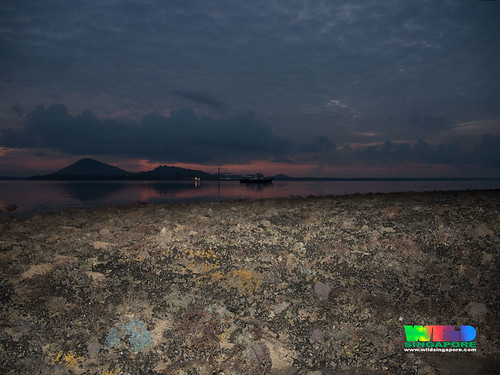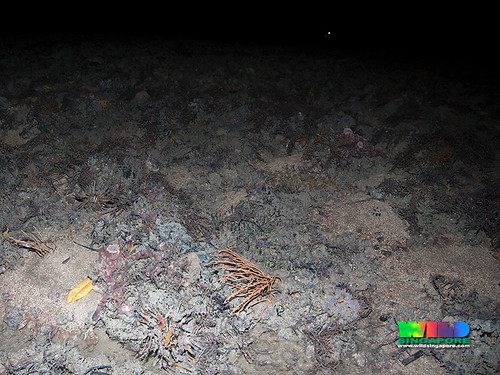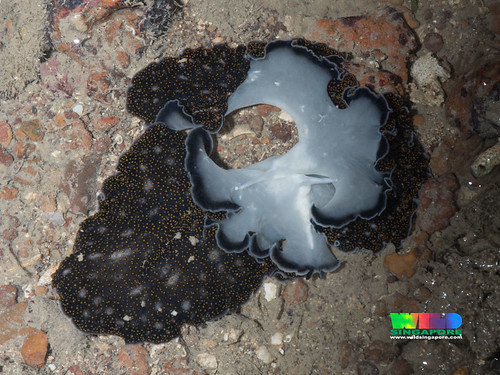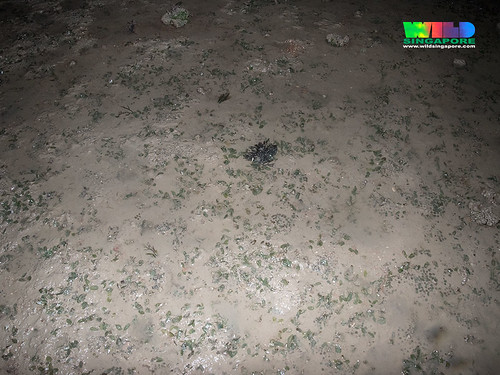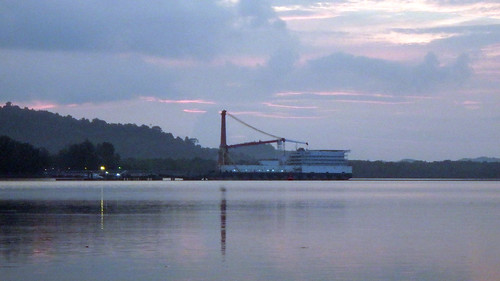Today, I'm relieved that I didn't see any coral bleaching. Although there were fewer hard corals, and I saw pale and 'melting' sponges as well as some pale flowery soft corals, we did see a wide variety of marine life. Nevertheless, Beting Bronok continues to decline and appears to be slowly dying.
There are still many colourful sponges, and some sea fans on the small richest corner of Beting Bronok.
The most abundant sponge were Yellow bumpy sponges, which seemed to dominate this shore since our survey in Aug 2015. And there were a variety of many other sponges in small clumps.
But I saw several clumps of sponges that look like they were melting or losing colour.
I saw a few hard corals, none of them were bleaching. I saw three small Boulder pore corals. A few Branching pore corals and some tiny patches of Neat hexa corals. This is much fewer than the number of colonies I saw on our survey in Jun 2016 during mass coral bleaching. I did not see any Big ring merulinid corals which were bleaching on our survey last year.
There were many Pink flowery soft corals. Most seemed alright although a few had yellowish tips. There were many Spiky flowery soft corals, none of them bleaching. But only a few Ball soft corals .
The most common anemone was Haddon's carpet anemones. Those I saw seemed alright.
Other anemones seen included many Swimming anemone, one Snaky anemone, one Mini carpet anemone and one Big hermit hitching anemone. The rest of the team also saw some special anemones such as the Glass anemone. Sadly, we didn't see any Haekel's anemones. Beting Bronok used to be home to many of them as recently as our survey in Aug 2015. Button zoanthids still cover vast areas of the reef. I also saw a small patch of Sea mat zoanthids.
I came across a few large cerianthids: Common ceriathids and one Black mouth cerianthid. There were also many small clumps of various hydroids including Fern hydroids and the nasty Stinging hydroids. Also many Candy hydroids although most of them were heavily covered in epiphytes.
There were also many Spiky sea pens, some Flowery sea pens and one Slender sea pen.
There were some Candelabra sea fans and Gnarled sea fans.
Here's some sea fans that seem different.
Among the most interesting encounters for me today was a pair of Spangled flatworms 'penis' fencing. There were many of these flatworms today. Marine flatworms are hermaphrodites, that is, each flatworm has both male and female reproductive organs. When two flatworms meet, they exchange sperm. Some species simply insert their needle-like penis anywhere in the body of the partner. This is not surprisingly called 'hypodermic impregnation'. In yet other species, each flatworm tries to impregnate the other without itself being impregnated, as it involves more energy to produce eggs. This results in a sort of 'penis-fencing' when the two flatworms meet!
I came across many large Biscuit sea stars, one large Knobbly sea star. Kok Sheng saw 15 Knobbly sea stars in deeper water! I also saw several Thorny sea urchins. I didn't see many sea cucumbers: one Thorny sea cucumber, a few Orange sea cucumbers and two Big synaptid sea cucumbers. The rest of the team also saw a Red scaly sea star, the Bordered sea star and a large Basket star. None of saw a feather star.
I saw several Blue dragons and one Ceratosoma gracillimum nudibranch. The rest of the team saw many more nudibranchs of various kinds.
There were many many Onyx cowries once again (there were few on our last survey in Jun 2016). I saw one False cowrie in a soft coral, two Noble volute snails and a few live Gong gong snails. None of us saw the Baler snail which we did see in Jun 2014. I saw only one octopus.
There were also many Fan bellied filefishes. I saw one False scorpionfish, one small Kite butterflyfish, two Pink-eared emperors and a large Toadfish out of the water (they usually do fine after the tide comes in).
I saw several Stone crabs, one Red egg crab, many Purple-legged swimming crabs and one well camouflaged Velcro crab.
A thick layer of fine silt has settled on large areas of the southern edge of Beting Bronok. Today, I saw sprinkles of Spoon seagrass with large leaf blades and some Hairy spoon seagrass here.

Beting Bronok slowly dying
Every year we visit Benting Bronok, we see less and less marine life. Today, the shore seems similar to what we saw in Jun 2016, which was better than during our last survey in Aug 2015. This is what the shore looked like today.
This is what the shore looked like in years past...
 |
| Growths of marine life in Jun 2016. |
 |
| Mostly zoanthids only on the shore, Aug 2015 |
 |
| Marine life on at Beting Bronok in 2014 |
 |
| Marine life on Beting Bronok in 2013. |
 |
| Colourful marine life at Beting Bronok in 2012. |
 |
| Beting Bronok in 2012. |
 |
| Beting Bronok in 2003. |
 |
| Beting Bronok in 2003. |
 |
| Sea fans on Beting Bronok in 2004. |
Where is Beting Bronok? What is it's status and future?
 |
| Click on image for larger view. |
It was good to see that Beting Bronok remains alive and full of fascinating creatures. But to me, it seems to be in steady decline since the reclamation started at nearby Pulau Tekong . It has since also been affected by the flooding that led to mass deaths at Chek Jawa in 2007, and the coral bleaching in 2010, a ferry ran aground on Beting Bronok in Jul 2011 and it suffered mass coral bleaching again in 2016. Here's some old photos of marine life at Beting Bronok. We can only hope for the best for this wonderful reef on our Northern shore.
There are plans that may affect Beting Bronok a in the not too distant future. These include plans to locate at Pengerang Johor, a petrochemical complex that was rejected in Taiwan for environmental and health reasons.
Today, we noticed some large scale construction going on at Pengerang Johor, opposite Beting Bronok.
Just as on our last survey in Jun 2016, today we didn't see any fish traps. We almost always see signs of fishing pressure on this reef on every survey. We also notice there are changes in the structure of the reef, the northern 'arm' around the lagoon appears to be much narrower.
Thanks to Chay Hoon for organising the trip. Our annual trips to Beting Bronok are bitter-sweet. Like visiting our favourite grandma and watching her painfully, slowly fade away. I feel privileged to have seen her at her best.
Photos by others on this trip
- Abel Yeo on facebook.
- Jianlin Liu on facebook.
- Marcus Ng on facebook.
- Kok Sheng on facebook.
- Chay Hoon on facebook.
- Choo Yi Feng on facebook.
- Lisa Lim on facebook.

